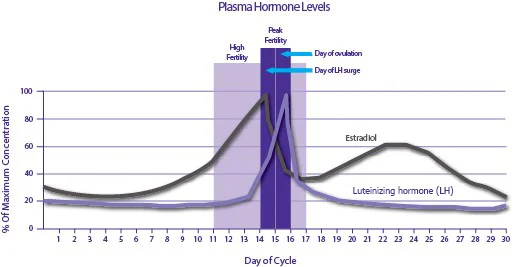Ovulation Calculator
Understanding when you are most fertile can improve your chances of conceiving, and being aware of when ovulation is likely to occur can help you identify your fertile period more accurately. Utilize our ovulation calculator to determine the days when ovulation is most probable.
Results are based on the information you have provided and data from the publication below: Sarah Johnson, Lorrae Marriott & Michael Zinaman (2018): “Can apps and calendar methods predict ovulation with accuracy?”, Current Medical Research and Opinion, DOI:10.1080/03007995.2018.1475348
NOTE: This ovulation calculator should only be used for information and not as a replacement for understanding your body. An ovulation calculator uses your average cycle length and last period date to estimate potential ovulation days, essentially applying the calendar method. A hormone test detects your individual hormone levels to provide an precise forecast for when you will ovulate and the days prior to ovulation.
Understanding your ovulation calculator results
Today, numerous ovulation calculators can be found to predict the timing of your fertile days. These calculators operate based on the calendar method and use general data rather than individual hormone levels. None of us are considered as ‘average’:
- Different women have different cycle lengths that can also vary from cycle to cycle – in reality, around 52% of menstrual cycles differ by 5 days or more.
- Ovulation timing can differ by a few days, even with consistent cycles.
What sets an ovulation calculator apart from a fertility calendar?
An ovulation calculator predicts the probability of egg release on a specific day during your menstrual cycle. A fertility calendar indicates the days when you have a higher chance of getting pregnant through intercourse.
Ovulation occurs when the ovary releases an egg, happening once in the menstrual cycle. An ovulation calculator gives an approximation of the likelihood of ovulation on specific days in your menstrual cycle and can assist in determining your most fertile days. These calculators operate by using the start date of your previous period and the duration of your menstrual cycle to estimate the days when ovulation may occur.
Once an egg is released, it has a lifespan of 24 hours, so being aware of your ovulation period provides a limited opportunity for conception through intercourse. You have an increased number of days when you can conceive because fertility is not solely determined by the egg’s lifespan, but also by the sperm’s. Sperm is able to remain viable inside a female body for as long as 5 days following sexual intercourse, allowing for the possibility of conception if intercourse occurs 4 or 5 days prior to ovulation. Typically, your fertility window spans approximately 6 days when both the egg and sperm can live.
Peak fertility days refer to the two most fertile days within a 6-day fertility window. This is the day prior to ovulation and the day of ovulation. An ovulation test detects the increase in luteinizing hormone (LH) levels occurring 24-36 hours prior to ovulation, allowing you to pinpoint your two most fertile days with precision.

Try our ovulation calculator to estimate the time of ovulation. Understanding your menstrual cycle better can make it simpler to identify your most fertile period.
Using an ovulation test that detects estradiol (a form of estrogen) can extend your fertility window. During the days before the LH surge, your estradiol levels will increase, eventually reaching a point that initiates the pre-ovulatory LH surge. Monitoring your estradiol and LH levels will help you pinpoint the days with highest fertility before ovulation.
By pinpointing the extra days of fertility prior to ovulation, you will be able to schedule intercourse according to your schedule and increase chances of becoming pregnant. This can alleviate the stress of attempting to conceive a child.
Alternative ways to identify ovulation, such as tracking basal body temperature and using the calendar method, only indicate post-ovulation, rendering them less useful for conception purposes.
What sets apart ‘ovulation’ from ‘fertile days’?
‘Ovulation’ is when an egg is released from an ovary, occurring 12-16 days before the next menstrual cycle begins.
The days of fertility occur in a woman’s menstrual cycle prior to and on the day of ovulation, allowing for potential pregnancy through unprotected sexual intercourse.



